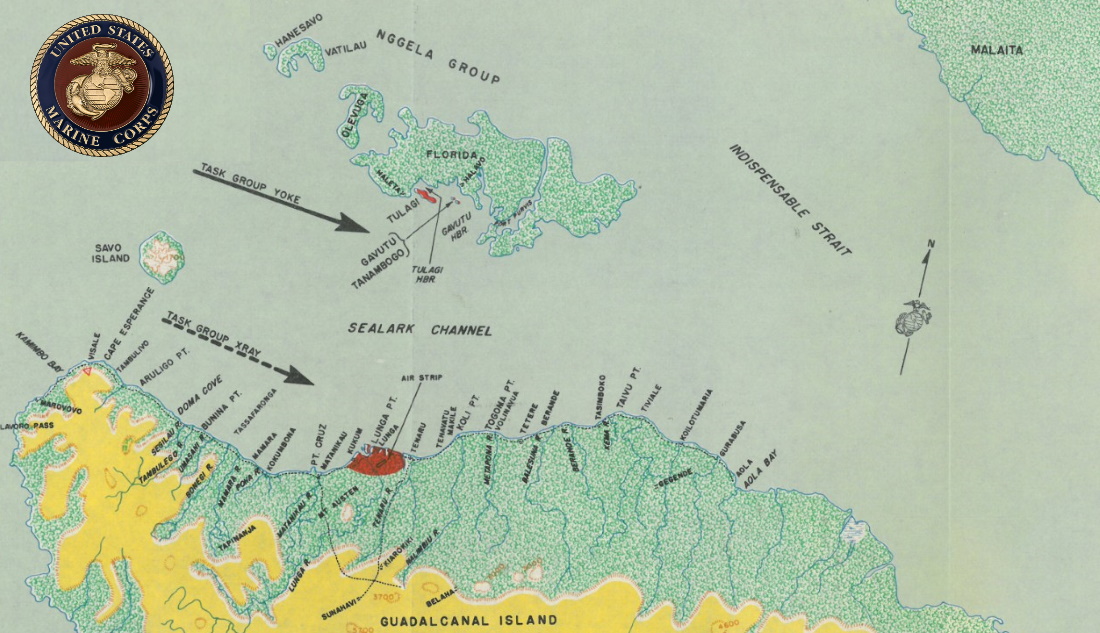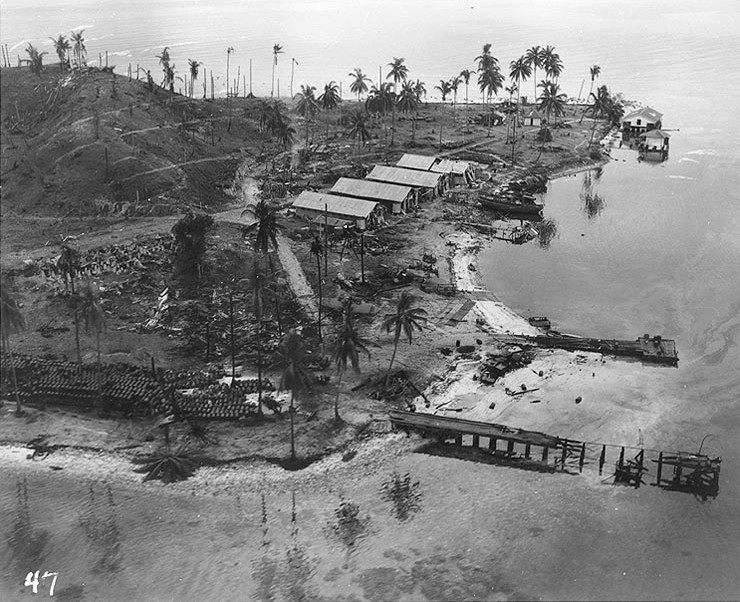RENDEZ-VOUS AT GAVUTU
 After four months of war, the 1st Marine Division was alerted to its first prospect of action. The vital Samoan Islands appeared to be next on the Japanese invasion list and the Navy called upon the Marines to provide the necessary reinforcements for the meager garrison. In March 1942, Headquarters created two brigades for the mission, cutting a regiment and a slice of supporting forces from each of the two Marine divisions. The 7th Marines got the nod at New River and became the nucleus of the 3rd Brigade.
After four months of war, the 1st Marine Division was alerted to its first prospect of action. The vital Samoan Islands appeared to be next on the Japanese invasion list and the Navy called upon the Marines to provide the necessary reinforcements for the meager garrison. In March 1942, Headquarters created two brigades for the mission, cutting a regiment and a slice of supporting forces from each of the two Marine divisions. The 7th Marines got the nod at New River and became the nucleus of the 3rd Brigade.
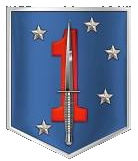
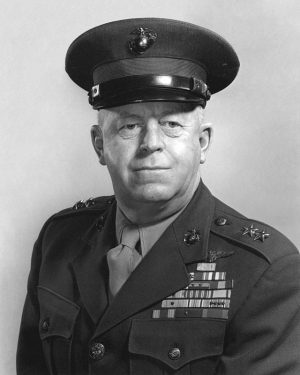 That force initially included Edson’s 1st Raider Battalion but no paratroopers. In the long run that was a plus for the 1st Parachute Battalion, which remained relatively untouched as the brigade siphoned off much of the best manpower and equipment of the division to bring itself to full readiness. The division already was reeling from the difficult process of wartime expansion. In the past few months, it had absorbed thousands of newly minted Marines, subdivided units to create new ones, given up some of its best assets to field the raiders and the parachutists, and built up a base and training areas from the pine forests of New River (North Carolina).
That force initially included Edson’s 1st Raider Battalion but no paratroopers. In the long run that was a plus for the 1st Parachute Battalion, which remained relatively untouched as the brigade siphoned off much of the best manpower and equipment of the division to bring itself to full readiness. The division already was reeling from the difficult process of wartime expansion. In the past few months, it had absorbed thousands of newly minted Marines, subdivided units to create new ones, given up some of its best assets to field the raiders and the parachutists, and built up a base and training areas from the pine forests of New River (North Carolina).
 The parachutists and the remainder of the division did not have long to wait for their own call to arms, however. In early April, Headquarters alerted the 1st Marine Division that it would begin movement overseas in May. The destination was New Zealand, where everyone assumed the division would have months to complete the process of turning raw manpower into well-trained units. Part of the division shoved off from Norfolk in May. Some elements, including Baker and Charlie Cos of the parachutists, took trains to the West Coast and boarded naval transports there on June 19. The rest of the 1st Parachute Battalion was part of a later Norfolk echelon, which set sail for New Zealand on June 10. While the parachutists were still at sea, the echelon of the division had already bedded down in New Zealand. But the 1st Marine Division’s commander, Gen Vandegrift, received a rude shock shortly after he and his staff settled into their headquarters at a Wellington Hotel. He and his outfit were slated to invade and seize islands in the Southern Solomon’s Group on August 1, just five weeks hence. To complicate matters, there was very little solid intelligence about the objectives. There were no maps on hand, so the division had to create its own from poor aerial photos and sketches hand-drawn by former planters and traders familiar with the area.
The parachutists and the remainder of the division did not have long to wait for their own call to arms, however. In early April, Headquarters alerted the 1st Marine Division that it would begin movement overseas in May. The destination was New Zealand, where everyone assumed the division would have months to complete the process of turning raw manpower into well-trained units. Part of the division shoved off from Norfolk in May. Some elements, including Baker and Charlie Cos of the parachutists, took trains to the West Coast and boarded naval transports there on June 19. The rest of the 1st Parachute Battalion was part of a later Norfolk echelon, which set sail for New Zealand on June 10. While the parachutists were still at sea, the echelon of the division had already bedded down in New Zealand. But the 1st Marine Division’s commander, Gen Vandegrift, received a rude shock shortly after he and his staff settled into their headquarters at a Wellington Hotel. He and his outfit were slated to invade and seize islands in the Southern Solomon’s Group on August 1, just five weeks hence. To complicate matters, there was very little solid intelligence about the objectives. There were no maps on hand, so the division had to create its own from poor aerial photos and sketches hand-drawn by former planters and traders familiar with the area.
Planners estimated that there were about 5275 enemies on Guadalcanal (home to a Japanese airfield under construction) and a total of 1850 on Tulagi and Gavutu-Tanambogo. Tulagi, 17 miles north of Guadalcanal, was valuable for its anchorage and seaplane base. The islets of Gavutu and Tanambogo, joined by a causeway, hosted a seaplane base and Japanese shore installations and menaced the approaches to Tulagi. In reality, there were probably 536 men on Gavutu-Tanambogo, most of them part of construction or aviation support units, though there was at least one platoon of the 3rd Kure Special Naval Landing Force, the ground combat arm of the Imperial Navy. The list of heavy weapons on Gavutu-Tanambogo included two three-inch guns (76.2-MM) and an assortment of AAA and AT guns and machine guns. By the time the last transports docked in New Zealand on July 11, planners had outlined the operation and the execution date had slipped to August 7 to allow the division a chance to gather its far-flung echelons and combat load transports.
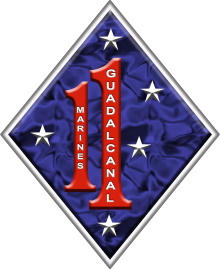
 Five battalions of the 1st and 5th Marines would land on the large island of Guadalcanal at 0800 on August 7 and seize the unfinished airfield on the north coast. The 1st Raider Battalion, slated to meet the division on the way to the objective, would simultaneously assault Tulagi. The 2/5th Marines, would follow in trace and support the raiders. The 2nd Marines, also scheduled to rendezvous with the division at sea, would serve as the reserve force and land 20 minutes prior to H-Hour on Florida Island, thought to be undefended.
Five battalions of the 1st and 5th Marines would land on the large island of Guadalcanal at 0800 on August 7 and seize the unfinished airfield on the north coast. The 1st Raider Battalion, slated to meet the division on the way to the objective, would simultaneously assault Tulagi. The 2/5th Marines, would follow in trace and support the raiders. The 2nd Marines, also scheduled to rendezvous with the division at sea, would serve as the reserve force and land 20 minutes prior to H-Hour on Florida Island, thought to be undefended.
Organization: Pestilence (TF-1), Watchover (Tulagi & Guadalcanal) and Cactus (Guadalcanal) VAdm Ghormley, exercising strategic command, set up his organization in three main groups. The Carrier Force (TF-61) commanded by RAdm Leigh Noyes, was composed of elements of three task forces from Nimitz’ area-11, 16, and 18. It would include three carriers – the Saratoga, the Enterprise, and the Wasp – the fast new battleship North Carolina, five heavy cruisers, one so-called antiaircraft cruiser, and 16 destroyers. The Amphibious Force (TF-62) commanded by RAdm Richmond K. Turner, USN, included the FMF Landing Force, 48 six heavy cruisers, two light cruisers, 15 destroyers, 13 attack transports, six attack cargo ships, four destroyer transport, and five minesweepers. Shore-Based Aircraft (TF-63) under command of RAdm J.S. McCain, USN, (Commander Aircraft South Pacific) included all aircraft in the area approximately 250 carrier aircraft available only under certain conditions, 166 Navy and Marine Corps planes including two USMC squadrons (VMF-212) and (VMO-251), 95 Army planes, and 30 planes from the Royal New Zealand Air Force, a total of 291 aircraft.

 The paratroopers received the mission of attacking Gavutu at H plus four hours. The delay resulted from the need for planes, ships, and landing craft to concentrate first in support of the Tulagi operation. Once the paratroopers secured Gavutu, they would move on to their sister unit.
The paratroopers received the mission of attacking Gavutu at H plus four hours. The delay resulted from the need for planes, ships, and landing craft to concentrate first in support of the Tulagi operation. Once the paratroopers secured Gavutu, they would move on to their sister unit.
The Tulagi, Gavutu-Tanambogo, and Florida operations fell under the immediate control of a task force designated as the Northern Group, headed by Gen William H. Rupertus, the assistant division commander. After a feverish week of unloading, sorting, and reloading equipment and supplies, the parachutists boarded the transport USS Heywood (DD-663) on July 18 and sailed in convoy to Koro Island in the Fijis, where the entire invasion force conducted landing rehearsals on July 28 and 30. These went poorly since the Navy boat crews and most of the 1st Marine Division was too green. The parachute battalion was better trained than most of the division, but this was its very first experience as a unit in conducting a seaborne landing. There is no indication that planners gave any thought to using their airborne capability, though in all likelihood that was due to the lack of transport aircraft or the inability of available planes to make a round-trip flight from New Zealand to the Solomons.
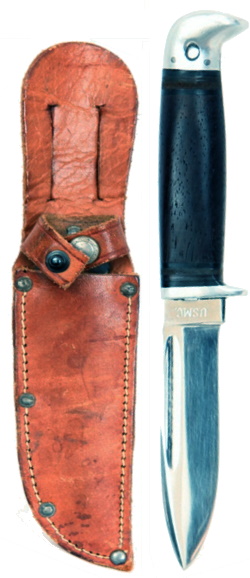 The paratroopers had the toughest mission in many respects. With a grand total of eight small infantry platoons, they had just 361 Marines, much less than half the manpower of other line battalions. More importantly, they lacked the punch of heavy mortars and machine guns and had fewer of the light versions of these weapons, too. Even their high proportion of individual automatic weapons would not help much; many of these were the unreliable Reising sub-machine gun. The late hour of their attack also sacrificed any element of surprise, though planners assumed that naval and aerial firepower would suppress Japanese defenders. Nor was terrain in their favor. The coral reef surrounding the islets meant that the only suitable landing site was the boat basin on the northeast coast of Gavutu, but that point was subject to flanking fire from defenders on Tanambogo. In addition, a steep ship soon opened up on the initial objectives while Marines clambered down cargo nets into landing craft.
The paratroopers had the toughest mission in many respects. With a grand total of eight small infantry platoons, they had just 361 Marines, much less than half the manpower of other line battalions. More importantly, they lacked the punch of heavy mortars and machine guns and had fewer of the light versions of these weapons, too. Even their high proportion of individual automatic weapons would not help much; many of these were the unreliable Reising sub-machine gun. The late hour of their attack also sacrificed any element of surprise, though planners assumed that naval and aerial firepower would suppress Japanese defenders. Nor was terrain in their favor. The coral reef surrounding the islets meant that the only suitable landing site was the boat basin on the northeast coast of Gavutu, but that point was subject to flanking fire from defenders on Tanambogo. In addition, a steep ship soon opened up on the initial objectives while Marines clambered down cargo nets into landing craft.
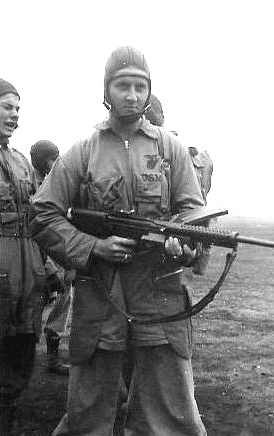 The parachutists watched while their fellow sea-soldiers conducted the first American amphibious assault of the war. As the morning progressed and opposition on Tulagi appeared light, the antiaircraft cruiser San Juan conducted three fire missions against Gavutu and Tanambogo, expending 1200 rounds in all. Just prior to noon, the supporting naval forces turned their full fury on the parachute battalion’s initial objective. San Juan poured 280 five-inch shells onto Gavutu in four minutes, then a flight of dive bombers from the carrier Wasp struck the northern side of the island, which had been masked from the fire of ships’ guns. Oily black smoke coral hill dominated the flat coastal area of each islet. Finally, despite a rule of thumb that the attackers should outnumber defenders by three to one in an amphibious assault, they were going up against a significantly larger enemy force. The parachutists’ only advantage was their high level of training and esprit. The US task force sailed into the waters between Guadalcanal and Florida Island in the pre-dawn darkness of August 7, 1942. Planes rose into the sky and most Marines assumed that few could survive such a pounding, but the display of firepower probably produced few casualties among the defenders, who had long since sought shelter in numerous caves and dugouts. The bombardment did destroy one three-inch gun on Gavutu, as well as the seaplane ramp the parachutists had hoped to land on, thus forcing the Higgins boats to divert to a nearby pier or a small beach. The intense preparation fires had momentarily stunned the defenders, however, and the first wave of Marines from Able Co clambered from their landing craft onto the dock against little opposition. The Japanese quickly recovered and soon opened up with heavier fire that stopped Able Co’s advance toward Hill 148 after the Marines had progressed just 75 yards. Enemy gunners also devoted some of their attention to the two succeeding waves and inflicted casualties as they made the long approach around Gavutu to reach the northern shore.
The parachutists watched while their fellow sea-soldiers conducted the first American amphibious assault of the war. As the morning progressed and opposition on Tulagi appeared light, the antiaircraft cruiser San Juan conducted three fire missions against Gavutu and Tanambogo, expending 1200 rounds in all. Just prior to noon, the supporting naval forces turned their full fury on the parachute battalion’s initial objective. San Juan poured 280 five-inch shells onto Gavutu in four minutes, then a flight of dive bombers from the carrier Wasp struck the northern side of the island, which had been masked from the fire of ships’ guns. Oily black smoke coral hill dominated the flat coastal area of each islet. Finally, despite a rule of thumb that the attackers should outnumber defenders by three to one in an amphibious assault, they were going up against a significantly larger enemy force. The parachutists’ only advantage was their high level of training and esprit. The US task force sailed into the waters between Guadalcanal and Florida Island in the pre-dawn darkness of August 7, 1942. Planes rose into the sky and most Marines assumed that few could survive such a pounding, but the display of firepower probably produced few casualties among the defenders, who had long since sought shelter in numerous caves and dugouts. The bombardment did destroy one three-inch gun on Gavutu, as well as the seaplane ramp the parachutists had hoped to land on, thus forcing the Higgins boats to divert to a nearby pier or a small beach. The intense preparation fires had momentarily stunned the defenders, however, and the first wave of Marines from Able Co clambered from their landing craft onto the dock against little opposition. The Japanese quickly recovered and soon opened up with heavier fire that stopped Able Co’s advance toward Hill 148 after the Marines had progressed just 75 yards. Enemy gunners also devoted some of their attention to the two succeeding waves and inflicted casualties as they made the long approach around Gavutu to reach the northern shore.



